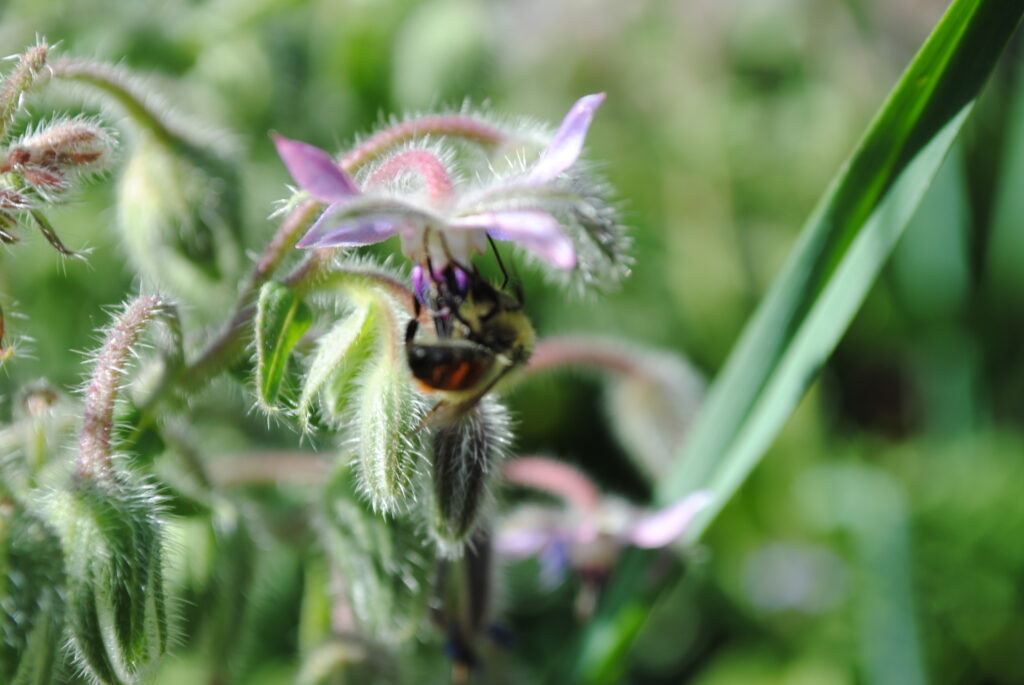Borage officinalis – Borage, Bee Bread, Common Bugloss and Starflower are a few of its common names. It grows 2 feet tall and wide and self-seeds. Its mature foliage is covered in prickly hairs. Pretty, star-shaped flowers in blue, lavender and pink bloom from May to hard frost. Bees, butterflies and moths prize its flower nectar. Originating in the Mediterranean, Borage officinalis prefers full sun, dry and or poor soil conditions. The large seeds easily disperse and are called nutlets.
Our adrenal glands have been over-worked this past year from worry, fear, anxiety and waiting, to name a few. This vital organ produces the hormone for the physical reaction to extreme stress, the “fight” or “flight” response. Suppressing the adrenal energy, as we often do when it’s emotionally triggered, this energy may manifest internally. This may lead to allergies, exhaustion, insomnia, skin rashes and other medical conditions. One of the best ways to channel adrenalin out is through movement such as stretching, dancing, walking, yoga, gardening, bike riding and even housecleaning! Let the feelings go, in any way you enjoy.
Plants known to naturally support the adrenal glands include Borage officinalis
- Borage leaves can act as a restorative agent on the adrenal cortex and may be drank as a tonic. Harvest the young leaves prior to flowering and hang or lay out to dry. Add 2 tsp. of the dried herb to a cup of boiling water, steep for 10-15 minutes. Enjoy.
- Omega-6 oils are found in most vegetable oils and in black currant, borage and primrose oil. The last three are the most therapeutic.
Fact or Folklore?
Pliny, the Roman naturalist, praised borage for its power to make men merry and joyful. Flowers steeped in wine were a popular remedy for melancholy!
In England you may hear it called “cool-tankard”, where an old verse relates,
“To enliven the sad with the joy of a joke,
Give a glass of wine with some borage put in it to soak.”
Persons recovering from long illnesses and those prone to swooning were administered candied borage flowers to lift their spirits.
Its medicinal mucilaginous properties are stored in the leaves and have been used for kidney and bladder ailments, to soothe sore throats, reduce fevers, and as a poultice to soothe skin inflammations.
For the Love of Latin
Knowing the botanical Latin of the plant you want will avert the confusion that common names cause. The Genus is the first part of a plant botanical name and refers to the family of origin and its first letter is always in upper case. The second name is the species name and refers to a feature of the plant and it is always in lower case.
Borage of the Boraginaceae Family officinalis- medicinal; of the pharmacopoeia
Annual Borage In the Garden
- Borage offers value with its medicinal, culinary and ornamental uses.
- Pollinators love borage nectar.
- For a cucumber flavor in salads, finely chop a few, young hairless leaves.
- Strawberries, squash and tomatoes like Borage as a companion plant: first by attracting bees for early pollination and second as a deterrent to the tomato horn worm.
- Borage flowers are a delicate edible.
Punch served by 19th Century English author Charles Dickens
2 cups water
½ cup of sugar
2tbp. Lemon peel
¼ cups barrage flowers
2 cups of sherry
1 cup of brandy
4 cups of apple cider
Pour boiling water over the sugar, lemon peel and borage, let sit 10 minutes. Strain and add sherry, brandy and cider.
How to make candied borage flowers
Be sure to use flowers that haven’t been sprayed with pesticides. Remove the stems and stamens from the flowers.
Beat an egg white until frothy. Brush flowers with beaten egg white or simple syrup using an artist’s paint brush OR use tweezers to gently pick up your flower, and dip it into the egg white/simple syrup, covering both sides.
Lay on a plate that you have spread with a thin layer of superfine sugar and sprinkle both sides; repeat with remaining flowers. The finer the sugar, the better!
Refrigerate, uncovered flowers on plate for 1 to 2 days. Store between sheets of wax paper in an airtight container in a cool, dry place. Will keep for 3 to 4 weeks. Lovely on desserts.
Other edible flowers: Lavender, Nasturtiums, Pansies, Roses and Violets.
May being in nature calm and restore you. Have a great 2021 gardening season.
Resources:
Alternative Medicine the Definitive Guide published by Celestial Arts, a division of Random House, Holistic Herbal by David Hoffman, published by Element Books Limited, NatureScape Alberta by Myrna Pearman & Ted Pike, publishers Red Deer River Naturalists and Federation of Alberta Naturalists
